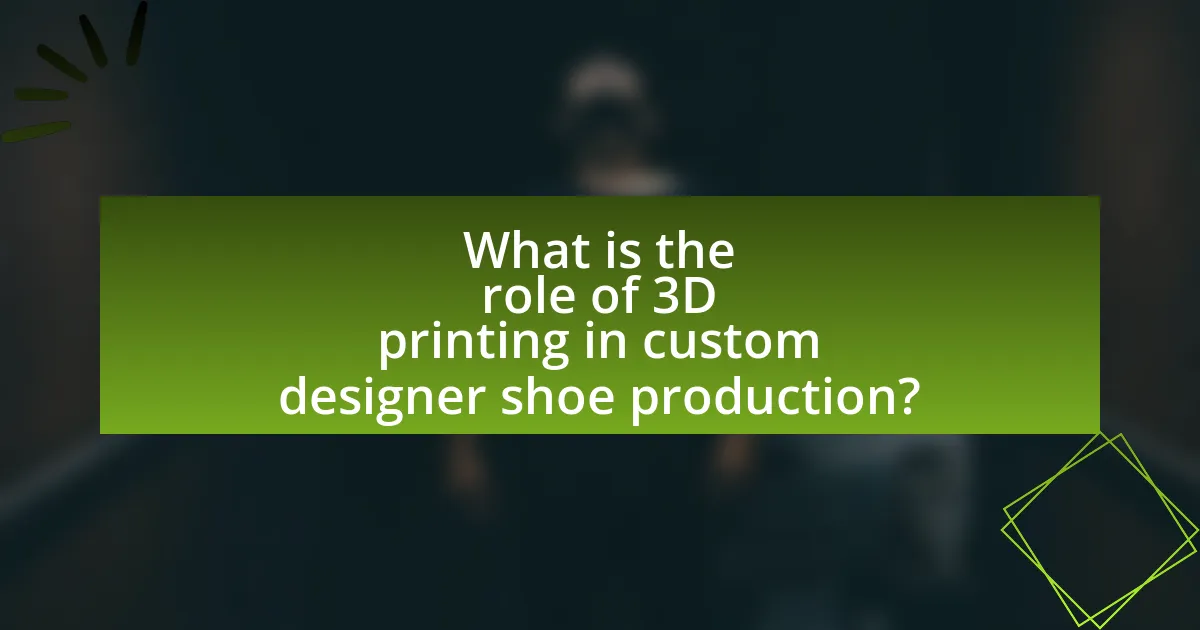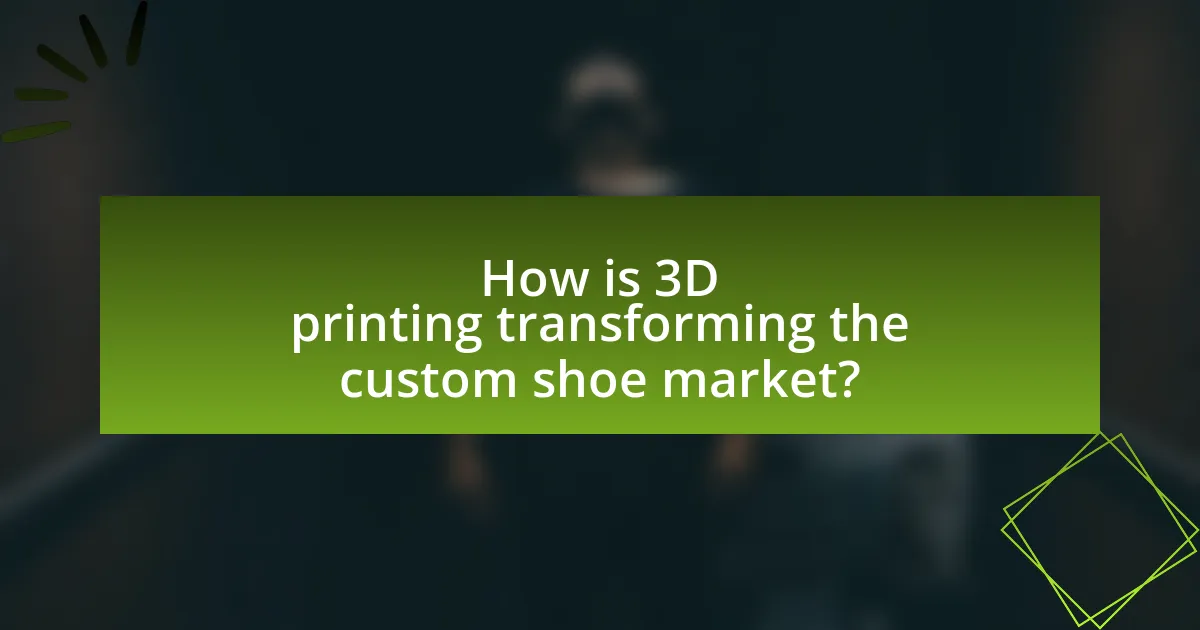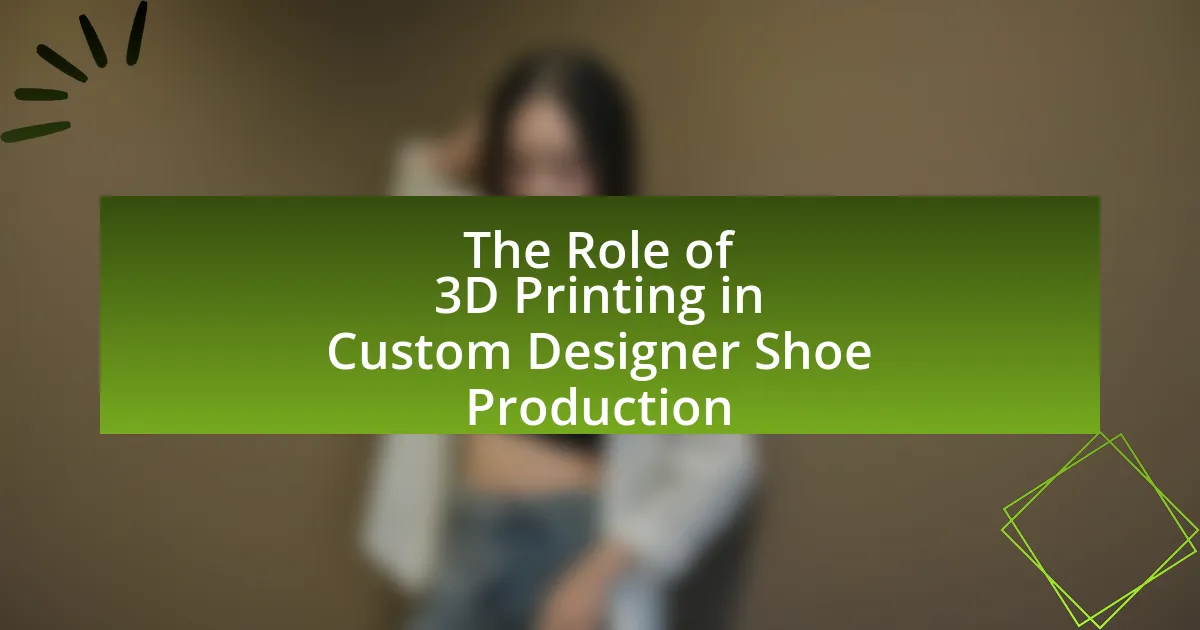The article examines the significant role of 3D printing in custom designer shoe production, highlighting its impact on rapid prototyping, personalization, and sustainability. It details how 3D printing technology allows for the creation of intricate shoe components tailored to individual preferences, enhancing comfort and performance while reducing material waste and production time. Key processes involved in 3D printing shoes, such as design, material selection, and printing techniques, are discussed, along with the advantages and challenges faced in the industry. The article also explores emerging trends, consumer preferences for personalized footwear, and future developments in 3D printing technology that could further transform the custom shoe market.

What is the role of 3D printing in custom designer shoe production?
3D printing plays a crucial role in custom designer shoe production by enabling rapid prototyping and personalized designs. This technology allows designers to create intricate and unique shoe components that can be tailored to individual customer preferences, enhancing both fit and aesthetics. For instance, brands like Adidas have utilized 3D printing to produce custom midsoles that conform to the wearer’s foot shape, improving comfort and performance. Additionally, 3D printing reduces material waste and production time, as designs can be adjusted and printed on-demand, streamlining the manufacturing process. This innovative approach not only meets the growing demand for customization in the fashion industry but also supports sustainable practices by minimizing excess inventory and resource consumption.
How does 3D printing technology work in the context of shoe production?
3D printing technology in shoe production involves creating footwear components layer by layer using digital models. This process begins with designing a shoe using computer-aided design (CAD) software, which allows for precise customization of fit, style, and materials. The digital model is then sliced into thin layers, and a 3D printer deposits material, such as thermoplastic polyurethane or other polymers, to build the shoe from the ground up.
This method enables rapid prototyping and production, significantly reducing lead times compared to traditional manufacturing methods. For instance, companies like Adidas have utilized 3D printing to produce the Futurecraft 4D shoe, which features a lattice structure designed for optimal performance and comfort. The ability to create complex geometries and personalized designs is a key advantage of 3D printing in the footwear industry, allowing brands to meet specific consumer demands efficiently.
What are the key processes involved in 3D printing shoes?
The key processes involved in 3D printing shoes include design, material selection, printing, and post-processing. The design phase utilizes computer-aided design (CAD) software to create a digital model of the shoe, allowing for customization and precision. Material selection is crucial, as various thermoplastics and elastomers are used to achieve desired properties such as flexibility and durability. The printing process typically employs techniques like Fused Deposition Modeling (FDM) or Selective Laser Sintering (SLS) to layer materials and construct the shoe. Finally, post-processing involves finishing touches such as cleaning, assembling components, and applying surface treatments to enhance aesthetics and performance. These processes collectively enable the production of tailored footwear that meets specific consumer needs.
How does 3D printing differ from traditional shoe manufacturing methods?
3D printing differs from traditional shoe manufacturing methods primarily in its production process, allowing for rapid prototyping and customization. Traditional methods often involve multiple steps such as cutting, stitching, and molding, which can be time-consuming and require significant labor and materials. In contrast, 3D printing utilizes additive manufacturing, where shoes are created layer by layer from digital designs, significantly reducing waste and enabling intricate designs that are difficult to achieve with conventional techniques. This method also allows for on-demand production, minimizing inventory costs and enabling personalized designs tailored to individual customer preferences.
What advantages does 3D printing offer for custom designer shoes?
3D printing offers significant advantages for custom designer shoes, including enhanced customization, reduced production time, and cost efficiency. The technology allows designers to create intricate and personalized designs tailored to individual preferences, which traditional manufacturing methods cannot achieve as easily. Additionally, 3D printing can produce prototypes and final products in a fraction of the time compared to conventional methods, enabling quicker turnaround for designers and consumers. Furthermore, the process minimizes material waste, as it uses only the necessary amount of material for each shoe, leading to lower production costs and a more sustainable approach to footwear manufacturing.
How does 3D printing enhance design flexibility for shoe designers?
3D printing enhances design flexibility for shoe designers by allowing for rapid prototyping and the creation of complex geometries that traditional manufacturing methods cannot achieve. This technology enables designers to experiment with intricate patterns, customized fits, and unique materials, facilitating a more innovative design process. For instance, a study by the Massachusetts Institute of Technology highlighted that 3D printing reduces the time from concept to prototype significantly, enabling designers to iterate designs quickly based on consumer feedback. This capability not only streamlines the design process but also empowers designers to push the boundaries of creativity in shoe design.
What cost benefits does 3D printing provide in shoe production?
3D printing provides significant cost benefits in shoe production by reducing material waste and lowering manufacturing costs. Traditional shoe production often involves cutting materials from larger sheets, leading to substantial waste; in contrast, 3D printing uses only the necessary amount of material, which can decrease costs by up to 90% in some cases. Additionally, 3D printing allows for rapid prototyping, enabling designers to create and test multiple iterations quickly, which can shorten the development cycle and reduce labor costs associated with traditional manufacturing processes. This efficiency can lead to overall savings in production time and resources, making 3D printing a financially advantageous method for producing custom designer shoes.
What challenges does 3D printing face in the shoe industry?
3D printing in the shoe industry faces several challenges, including material limitations, production speed, and scalability. Current 3D printing materials often lack the durability and flexibility required for high-performance footwear, which can hinder their adoption. Additionally, the speed of 3D printing processes is generally slower compared to traditional manufacturing methods, making it difficult to meet high demand efficiently. Scalability remains a significant issue, as transitioning from prototyping to mass production requires substantial investment in technology and infrastructure, which many companies may find prohibitive. These challenges collectively impact the widespread implementation of 3D printing in custom designer shoe production.
What limitations exist in materials used for 3D printed shoes?
The limitations in materials used for 3D printed shoes include restricted flexibility, durability issues, and limited aesthetic options. Many 3D printing materials, such as thermoplastics, may not provide the necessary flexibility required for comfortable footwear, leading to stiffness in the final product. Additionally, some materials may not withstand wear and tear effectively, resulting in reduced lifespan and performance. Furthermore, the range of colors and textures available in 3D printing materials can be limited compared to traditional shoe manufacturing methods, which can restrict design creativity and customization.
How do production speed and scalability affect 3D printed shoe production?
Production speed and scalability significantly enhance 3D printed shoe production by enabling rapid prototyping and mass customization. Faster production speeds allow designers to iterate on shoe designs quickly, reducing the time from concept to market. For instance, companies like Adidas have utilized 3D printing to produce shoe components in as little as 24 hours, demonstrating the technology’s capability to meet consumer demands swiftly. Scalability ensures that once a design is finalized, it can be produced in larger quantities without compromising quality, as seen in the production of Nike’s 3D printed Flyknit shoes, which combines both speed and scalability to meet high-volume orders efficiently. This dual advantage leads to increased market responsiveness and the ability to cater to diverse consumer preferences.

How is 3D printing transforming the custom shoe market?
3D printing is transforming the custom shoe market by enabling rapid prototyping and personalized designs tailored to individual customer preferences. This technology allows manufacturers to create unique shoe components with intricate designs that traditional methods cannot achieve, significantly reducing production time and costs. For instance, companies like Adidas have utilized 3D printing to produce custom midsoles, which can be tailored to the specific foot shape and performance needs of athletes, enhancing comfort and functionality. Additionally, a report from Wohlers Associates indicates that the global 3D printing market is expected to reach $34.8 billion by 2024, highlighting the growing adoption of this technology in various industries, including footwear.
What trends are emerging in the custom shoe market due to 3D printing?
Emerging trends in the custom shoe market due to 3D printing include increased personalization, rapid prototyping, and sustainable production methods. Personalization allows consumers to design shoes tailored to their specific preferences, with companies like Adidas and Nike offering customizable options through 3D printing technology. Rapid prototyping enables designers to quickly create and test new shoe models, significantly reducing the time from concept to market. Additionally, sustainable production methods are gaining traction, as 3D printing minimizes material waste and allows for the use of eco-friendly materials, aligning with the growing consumer demand for environmentally responsible products. These trends are reshaping the custom shoe landscape, making it more innovative and consumer-centric.
How are consumer preferences shifting towards personalized footwear?
Consumer preferences are shifting towards personalized footwear due to the increasing demand for unique and customized products that reflect individual identity and style. This trend is driven by advancements in technology, particularly 3D printing, which allows for the creation of bespoke designs tailored to specific consumer needs. According to a report by Allied Market Research, the global custom footwear market is projected to reach $9.5 billion by 2025, indicating a significant growth in consumer interest in personalized options. Additionally, brands that offer customization features, such as Nike and Adidas, have reported higher customer engagement and satisfaction, further validating the shift towards personalized footwear.
What role do collaborations between designers and 3D printing companies play?
Collaborations between designers and 3D printing companies play a crucial role in enhancing the customization and efficiency of shoe production. These partnerships enable designers to leverage advanced 3D printing technologies, allowing for the creation of intricate and personalized designs that traditional manufacturing methods cannot achieve. For instance, brands like Nike and Adidas have utilized 3D printing to produce bespoke shoe components, significantly reducing production time and material waste. This synergy not only fosters innovation in design but also meets consumer demand for unique, tailored products, as evidenced by the growing trend of on-demand manufacturing in the footwear industry.
How are brands leveraging 3D printing for competitive advantage?
Brands are leveraging 3D printing for competitive advantage by enabling rapid prototyping and customization of shoe designs. This technology allows brands to quickly iterate on designs, reducing the time from concept to market. For instance, companies like Adidas have utilized 3D printing to create personalized shoe components, enhancing fit and performance for individual customers. Additionally, 3D printing reduces material waste and production costs, as brands can produce only what is needed, aligning with sustainable practices. According to a report by Wohlers Associates, the global 3D printing market is projected to reach $35.6 billion by 2024, indicating significant investment and growth in this area, further validating its impact on competitive positioning in the footwear industry.
What innovative designs have been created using 3D printing technology?
Innovative designs created using 3D printing technology in custom designer shoe production include personalized insoles, intricate lattice structures for lightweight footwear, and fully customized shoe uppers tailored to individual foot shapes. These designs leverage the capabilities of 3D printing to produce complex geometries that traditional manufacturing methods cannot achieve, enhancing comfort and performance. For instance, companies like Adidas have utilized 3D printing to create the Futurecraft 4D shoe, which features a 3D-printed midsole designed for optimal cushioning and support, demonstrating the technology’s potential to revolutionize footwear design.
How do brands market their 3D printed custom shoes to consumers?
Brands market their 3D printed custom shoes to consumers through targeted digital marketing strategies, leveraging social media platforms, influencer partnerships, and personalized advertising. For instance, brands utilize platforms like Instagram and TikTok to showcase the unique design process and customization options, engaging consumers with visually appealing content. Additionally, collaborations with influencers who resonate with the target audience help amplify brand visibility and credibility. According to a report by Statista, 54% of consumers are influenced by social media when making purchasing decisions, highlighting the effectiveness of these marketing strategies in reaching potential buyers.

What future developments can we expect in 3D printing for custom designer shoes?
Future developments in 3D printing for custom designer shoes will likely include advancements in materials, increased personalization options, and enhanced production efficiency. Innovations in biocompatible and sustainable materials will enable designers to create shoes that are not only aesthetically pleasing but also environmentally friendly. Additionally, the integration of artificial intelligence in design software will allow for greater customization, enabling consumers to tailor shoes to their specific preferences and foot anatomy. Furthermore, improvements in 3D printing technology, such as faster printing speeds and multi-material capabilities, will streamline the production process, reducing lead times and costs. These trends are supported by ongoing research and development in the field, indicating a significant shift towards more innovative and consumer-focused shoe production methods.
How might advancements in technology impact 3D printing in shoe production?
Advancements in technology will significantly enhance 3D printing in shoe production by improving material properties, increasing printing speed, and enabling complex designs. For instance, the development of new thermoplastic elastomers allows for greater flexibility and durability in printed shoes, which can lead to better performance and comfort. Additionally, innovations in printing techniques, such as multi-material printing, enable the creation of shoes with varying textures and functionalities in a single print run. According to a report by Wohlers Associates, the 3D printing market is expected to grow to $35.6 billion by 2024, indicating a strong trend towards integrating advanced technologies in manufacturing processes, including footwear. This growth reflects the increasing adoption of 3D printing technologies in various industries, including fashion and footwear, driven by the demand for customization and rapid prototyping.
What new materials are being researched for 3D printed footwear?
Researchers are exploring several innovative materials for 3D printed footwear, including thermoplastic polyurethane (TPU), bio-based polymers, and advanced composites. TPU is favored for its flexibility and durability, making it suitable for various shoe designs. Bio-based polymers, derived from renewable resources, are being investigated for their environmental benefits and potential to reduce the carbon footprint of footwear production. Advanced composites, which combine different materials to enhance performance characteristics, are also being studied to improve the strength-to-weight ratio and overall functionality of 3D printed shoes. These materials are being validated through studies that demonstrate their mechanical properties and suitability for mass production in the footwear industry.
How could sustainability initiatives influence the future of 3D printed shoes?
Sustainability initiatives could significantly influence the future of 3D printed shoes by promoting the use of eco-friendly materials and reducing waste in the production process. As consumers increasingly demand environmentally responsible products, manufacturers are likely to adopt biodegradable and recycled materials for 3D printing, which can minimize the carbon footprint associated with traditional shoe manufacturing. For instance, companies like Adidas have already begun experimenting with 3D printing technologies that utilize recycled ocean plastics, demonstrating a commitment to sustainability. Furthermore, 3D printing allows for on-demand production, which can reduce overproduction and excess inventory, aligning with sustainable practices. This shift not only meets consumer expectations but also positions brands as leaders in the sustainable fashion movement.
What best practices should designers follow when using 3D printing for shoes?
Designers should prioritize material selection, design optimization, and prototyping when using 3D printing for shoes. Selecting appropriate materials, such as flexible thermoplastics, ensures durability and comfort, which are essential for footwear. Optimizing designs for 3D printing involves creating structures that minimize weight while maintaining strength, often utilizing lattice structures or varying thicknesses. Prototyping allows designers to test fit and functionality, enabling iterative improvements based on user feedback. These practices enhance the overall quality and performance of 3D-printed shoes, aligning with industry standards for footwear production.
How can designers optimize their designs for 3D printing efficiency?
Designers can optimize their designs for 3D printing efficiency by utilizing design software that supports additive manufacturing principles, such as minimizing material usage and enhancing structural integrity. By employing techniques like lattice structures and hollow designs, designers can reduce weight and material costs while maintaining strength. Additionally, incorporating features that align with the 3D printing process, such as avoiding overhangs and ensuring proper orientation, can significantly improve printability and reduce the need for support structures. Research indicates that optimizing these design elements can lead to a reduction in printing time and material waste, enhancing overall production efficiency in custom designer shoe manufacturing.
What common pitfalls should be avoided in 3D printed shoe production?
Common pitfalls to avoid in 3D printed shoe production include inadequate material selection, poor design optimization, and insufficient testing for comfort and durability. Inadequate material selection can lead to shoes that lack the necessary flexibility and strength, as certain materials may not perform well under stress. Poor design optimization often results in shoes that do not fit well or do not provide adequate support, which can affect user experience. Insufficient testing for comfort and durability can result in products that fail to meet consumer expectations, leading to negative reviews and financial losses. These pitfalls highlight the importance of thorough research and development in the 3D printing process for footwear.



